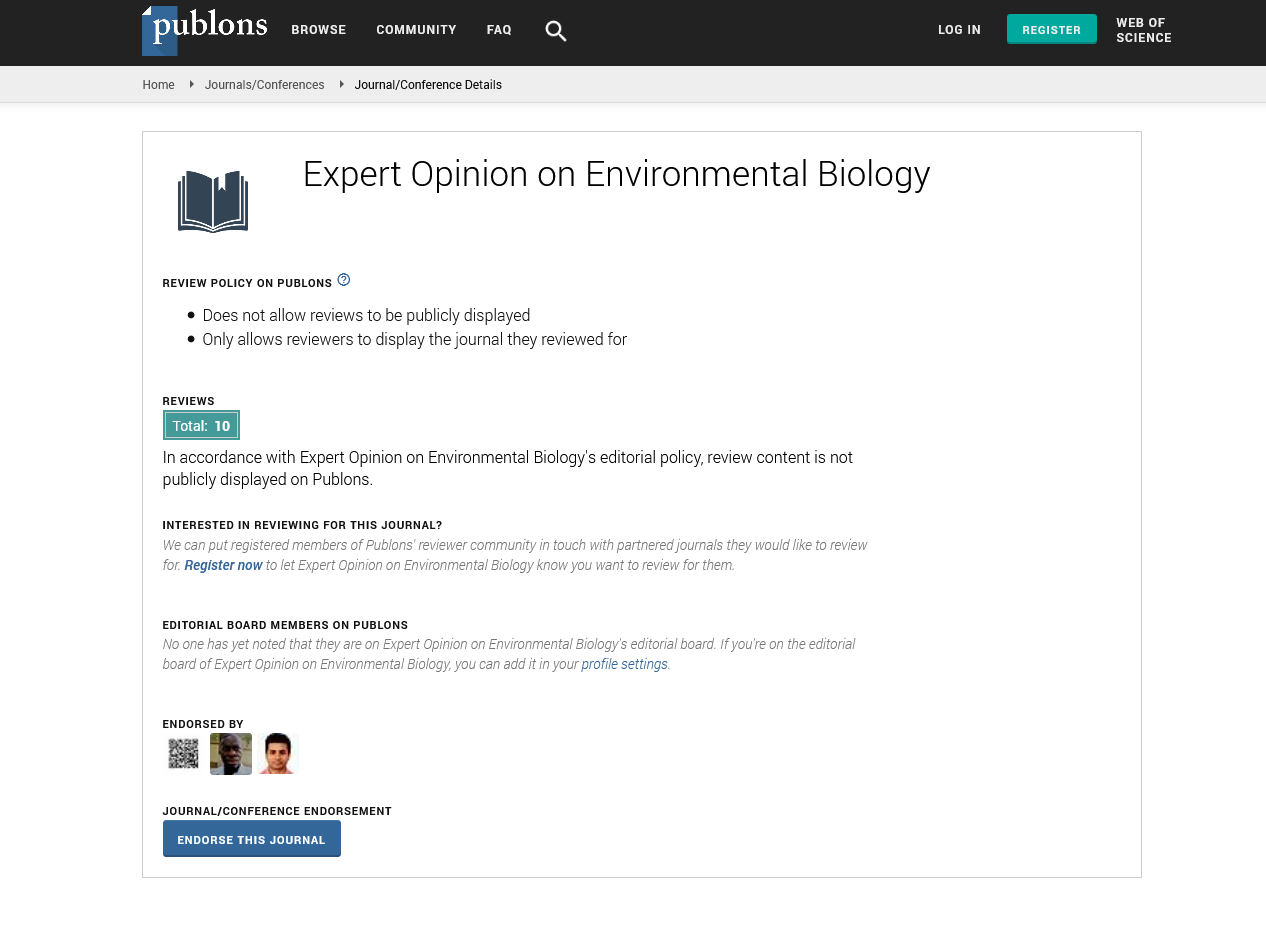Perspective, Expert Opin Environ Biol Vol: 13 Issue: 4
Examining the Role of Bioremediation in Pollution Control
Fiun Lieng*
1Department of Environmental Science and Engineering, Nankai University, Tianjin, China
*Corresponding Author: Xing Zhou,
Department of Environmental Science and
Engineering, Nankai University, Tianjin, China
E-mail: fiun_lieng@nu21.cn
Received date: 27 November, 2024, Manuscript No. EOEB-24-154084;
Editor assigned date: 29 November, 2024, PreQC No. EOEB-24-154084 (PQ);
Reviewed date: 13 December, 2024, QC No EOEB-24-154084;
Revised date: 20 December, 2024, Manuscript No. EOEB-24-154084 (R);
Published date: 27 December, 2024, DOI: 10.4172/2325-9655.1000227.
Citation: Lieng F (2024) Examining the Role of Bioremediation in Pollution Control. Expert Opin Environ Biol 13:4.
Description
As environmental pollution continues to rise globally, bioremediation has become an innovative, eco-friendly solution to reduce its adverse effects. Bioremediation uses the natural capabilities of microorganisms, plants and fungi to detoxify, degrade or remove pollutants from soil, water and air. By using nature’s inherent mechanisms, this technology provides a sustainable approach to pollution control, addressing issues ranging from industrial waste to oil spills and heavy metal contamination. Bioremediation utilizing biological processes to break down pollutants into less harmful substances. Microorganisms such as bacteria, fungi and archaea play a key role by metabolizing toxic compounds as part of their energy cycle. Plants and their associated microorganisms contribute through phytoremediation, absorbing and stabilizing contaminants in their tissues. This approach not only cleans up pollutants but also restores the ecological balance of degraded environments.
Microorganisms such as Pseudomonas, Bacillus and Aspergillus are employed to degrade organic pollutants like hydrocarbons, pesticides and solvents. They convert these harmful substances into water, carbon dioxide and biomass. Plants such as willow, poplar and sunflower are used to extract, stabilize or degrade contaminants. Phytoremediation is particularly effective in managing heavy metal contamination and is often employed in mining and industrial sites. Fungi such as white rot fungi and oyster mushrooms are utilized for their ability to break down persistent organic pollutants, including dyes, plastics and oil. These techniques involve enhancing the natural microbial activity in contaminated environments. Bioventing provides oxygen to existing microbes, while bioaugmentation introduces specialized microbial strains to accelerate degradation. Biostimulation method stimulates native microbial communities by adding nutrients or changing environmental conditions to enhance pollutant degradation.
Oil spills are among the most severe environmental disasters, causing long-term damage to marine and terrestrial ecosystems. Bioremediation has proven effective in breaking down hydrocarbons in oil, using bacteria such as Alcanivorax borkumensis to restore polluted environments. Industries release a wide array of pollutants, including solvents, dyes and heavy metals. Bioremediation techniques shows these pollutants by degrading organic compounds and stabilizing or extracting metals. Excessive use of pesticides and fertilizers contaminates soil and water bodies. Bioremediation helps degrade these chemicals, reducing their environmental impact and preserving soil health. Landfills generate leachate and gases, which pollute surrounding areas. Bioremediation techniques such as biocapping and methane recovery reduce these issues while recovering useful by-products. Water pollution from industrial effluents and agricultural runoff can be effectively treated using bioremediation. Biofilters and constructed wetlands are examples of systems designed to remove contaminants biologically. Bioremediation avoids the use of harsh chemicals or physical methods, minimizing secondary pollution and preserving biodiversity.
Compared to traditional cleanup methods, bioremediation is often more affordable due to its relies on natural processes and minimal equipment. This method can be applied to a wide range of pollutants, from hydrocarbons to heavy metals and is suitable for diverse environments such as soil, water and air. In-situ bioremediation techniques treat contamination directly at the site, reducing the need for digging or transport and maintaining the ecological integrity of the area. Beyond removing pollutants, bioremediation often restores the natural fertility and functionality of ecosystems, ensuring long-term sustainability. Some pollutants, such as Polychlorinated Biphenyls (PCBs) and radioactive waste are resistant to microbial degradation, requiring additional treatments.
Conclusion
Bioremediation is a powerful tool in the fight against environmental pollution, providing a natural and sustainable approach to restoring ecosystems. While challenges remain, continued studies and technological advancements potential to enhance its efficiency and applicability. By advancing in bioremediation, one can address pollution while preserving the planet's ecological stability, developing a cleaner and more sustainable future.
 Spanish
Spanish  Chinese
Chinese  Russian
Russian  German
German  French
French  Japanese
Japanese  Portuguese
Portuguese  Hindi
Hindi 
